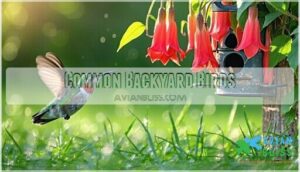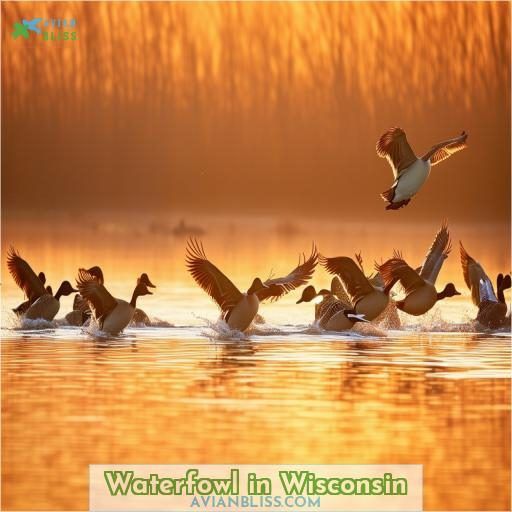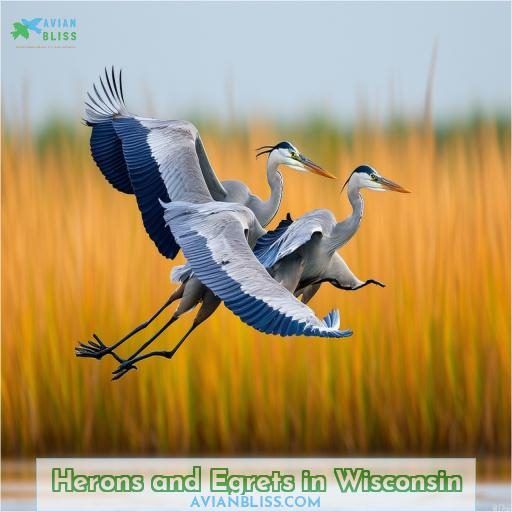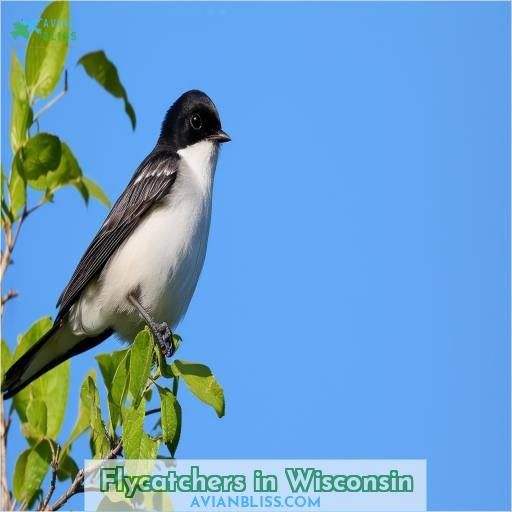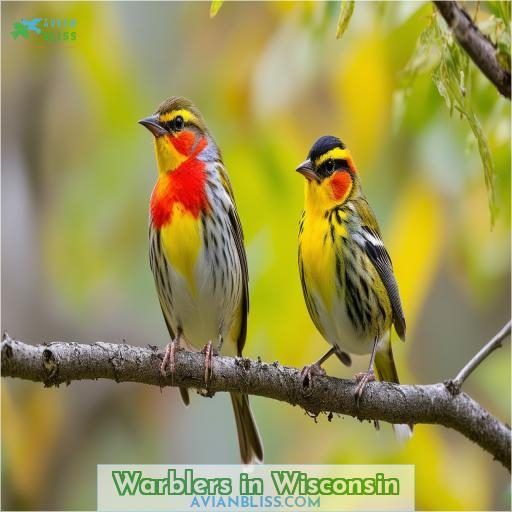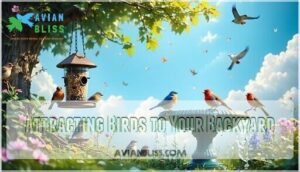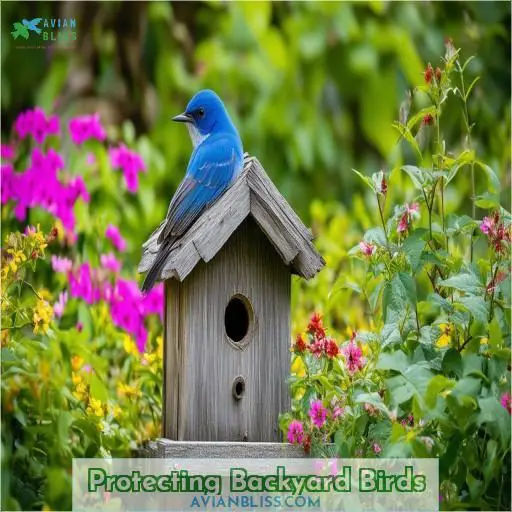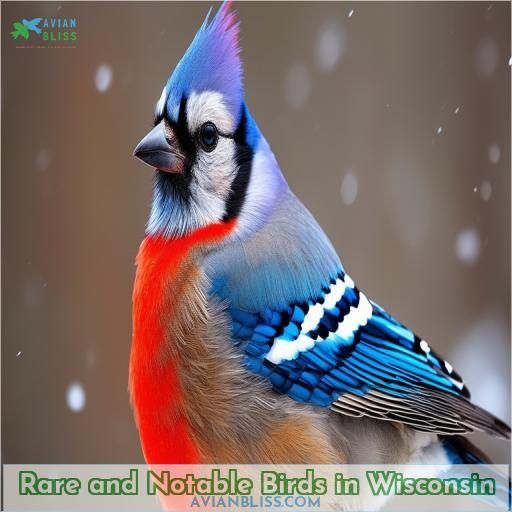This site is supported by our readers. We may earn a commission, at no cost to you, if you purchase through links.
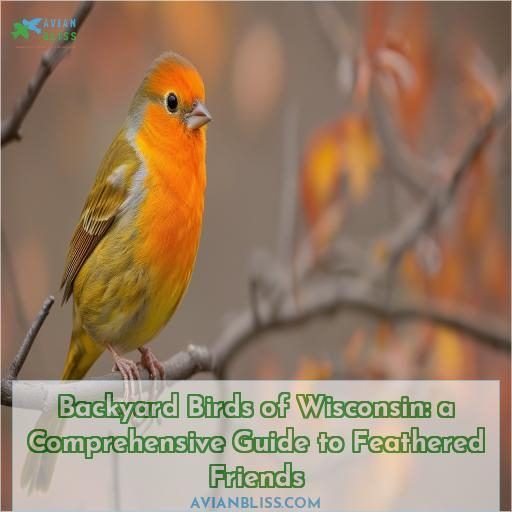
These feathered friends bring color and life to your outdoor space.
Keep an eye out for the ruby-throated hummingbird’s iridescent plumage and the American robin’s rusty breast as it hops across your lawn.
The tufted titmouse’s cheerful calls and acrobatic foraging will delight you as you observe nature’s wonders right outside your door.
But their presence hints at the remarkable diversity waiting to be discovered if you’re willing to explore further.
Table Of Contents
- Key Takeaways
- Common Backyard Birds
- Waterfowl in Wisconsin
- Herons and Egrets in Wisconsin
- Hawks and Eagles in Wisconsin
- Flycatchers in Wisconsin
- Warblers in Wisconsin
- Identifying Backyard Birds
- Attracting Birds to Your Backyard
- Protecting Backyard Birds
- Rare and Notable Birds in Wisconsin
- Frequently Asked Questions (FAQs)
- How do I identify a bird in my backyard?
- What is the rarest bird in Wisconsin?
- What bird is native to Wisconsin?
- How do I know what birds are in my area?
- What is the best bird feeder setup?
- How do I deter squirrels from eating birdseed?
- What plants attract the most birds to yards?
- When is the best time to clean birdhouses?
- Conclusion
Key Takeaways
- Imagine yourself as a backyard birder, delighting in the vibrant colors and lively melodies of Wisconsin’s feathered residents – from the ruby-throated hummingbird‘s dazzling acrobatics to the tufted titmouse’s cheerful chatter, your outdoor oasis comes alive!
- Creating an inviting habitat is key to attracting a diverse array of avian visitors. Provide a buffet of natural and supplemental food sources, fresh water for drinking and bathing, and cozy nesting spots tailored to their specific needs. Your backyard will soon become a bustling avian retreat!
- Identifying these winged wonders is half the fun! Keep an eye out for distinctive plumages, behaviors, and vocalizations – from the northern cardinal’s fiery hue to the downy woodpecker’s rhythmic tapping. Embrace your inner ornithologist and let their unique traits captivate you.
- While delighting in their presence, remember to be a responsible backyard birder. Reduce pesticide use, prevent window collisions, and keep furry feline friends indoors. Your eco-conscious choices ensure these feathered marvels thrive in a safe, nurturing environment.
Common Backyard Birds
The ruby-throated hummingbird, a tiny jewel of the skies, is a common sight in Wisconsin backyards during the warmer months. It hovers effortlessly as it sips nectar from flowering plants.
The American robin, with its distinctive rusty-red breast, is a familiar friend. It is often seen hopping across lawns in search of worms and insects.
Equally recognizable is the vibrant northern cardinal. Its bright red plumage is a welcome splash of color against the winter landscape.
The tufted titmouse, with its perky crest, entertains with its cheerful calls.
Rounding out this quintessential backyard quintet is the downy woodpecker, a diminutive yet industrious driller of trees. Its undulating flight pattern is a delight to observe.
Ruby-throated Hummingbird
You’ll often spot ruby-throated hummingbirds hovering at nectar sources with their:
- Iridescent green feathers
- Rapid wing-beats
- Long, slender bills
- Dazzling red throat (males)
These tiny birds migrate annually from Mexico and the Caribbean to breed across eastern North America. By providing nectar feeders and native flowering plants, you can attract these aerial acrobats to your backyard.
American Robin
You’ll often greet the American robin’s cheerful song in spring, as these harbingers of warmer weather migrate back to Wisconsin. Renowned for their skill at nabbing worms with a tilt of the head, robins thrive in backyard settings. Support their winter survival by leaving bushes and shrubs unmowed over fall to provide essential food sources.
Northern Cardinal
After welcoming the American robin, you’ll likely spot the vivid northern cardinal, a beloved backyard visitor. Admire the male’s brilliant red plumage as he:
- Fiercely guards his territory
- Sings his cheerful, whistled song
- Feeds his mate during nesting season
The female’s muted colors provide camouflage while incubating eggs in their well-concealed nest.
Tufted Titmouse
You’ll be enchanted by the Tufted Titmouse‘s audacious nesting habits – brazenly plucking fur from living animals like raccoons! These acrobatic foragers snatch insects with nimble flits, and their vocal repertoire includes a whistled "peter-peter-peter" call. During frigid winters, they’ll readily visit feeders for high-energy seeds that sustain their vibrant presence.
Downy Woodpecker
You’ll often spot the downy woodpecker, the smallest North American woodpecker, foraging for:
- Insects and grains in weed stems
- Grubs and beetles under bark
- Sap from sapsucker drillings
- Berries and seeds at feeders
Its small size allows it to access prey missed by larger woodpeckers, making it an important part of backyard ecosystems.
Waterfowl in Wisconsin
You’re likely to spot several species of waterfowl in Wisconsin‘s backyard ponds, lakes, and wetlands. The majestic Canada goose, the mute swan with its curved neck, the trumpeter swan (North America’s heaviest flying bird), the vibrantly patterned wood duck, and the distinctive gadwall with its brown and white plumage frequent these watery habitats.
Canada Goose
As iconic waterfowl, the Canada goose is easily identified by its brown body and black head and neck.
You’ve likely observed these large birds grazing on grassy fields or flying in V-formations during their incredible migratory journeys.
While their diet consists mainly of aquatic plants, they play a significant role in wetland ecosystems.
Responsible for monogamous mating pairs and strong family bonds, safeguarding Canada geese guarantees these majestic birds continue to flourish.
Mute Swan
Like their majestic cousins, you may spot mute swans gliding serenely across Wisconsin’s waterways. These graceful birds, however, face their own challenges:
- Habitat loss threatens their wetland homes
- Invasive species disrupt their food sources
- Climate change alters their migration patterns
- Hunting pressures reduced historical populations
- Conservation efforts aim to protect their future
Learn how you can help safeguard these regal yet vulnerable creatures.
Trumpeter Swan
You’ll spot the majestic trumpeter swan on Wisconsin’s wetlands and lakes. These massive waterfowl, weighing over 26 pounds, are North America’s heaviest flying birds, requiring over 300 feet to take flight. Support their conservation by protecting their wetland habitats as they migrate through the state, grazing on aquatic plants, insects, and mollusks.
Wood Duck
You’ll surely spot the striking wood duck, a cavity nester with chicks boasting strong claws to grip bark. Attract these beauties by providing nest boxes near wooded wetlands. Delight in watching the ducklings’ acrobatics as they pursue and catch aerial insects—a woodpecker-like trait!
- Iridescent plumage shimmers green, purple, and blue
- Females expertly lead ducklings to water after hatching
- Courtship displays are an elaborate, ritualized dance
- Excellent swimmers, but clumsy on land
- Benefit from nest box programs in suburban areas
Gadwall
You might spot a plump, gray gadwall dabbling in shallow wetlands or ponds. These ducks feast on aquatic plants, seeds, and insects found in marshes and flooded fields. While gadwalls breed across the northern U.S. and prairie provinces, they migrate south for winter. Their healthy populations reflect successful wetland conservation efforts.
Herons and Egrets in Wisconsin
You can easily spot herons and egrets wading in shallow waters or stalking through wetlands, thanks to their long legs and necks. The American Bittern, Least Bittern, Great Blue Heron, Great Egret, and Snowy Egret are among the species found in Wisconsin, making these elegant wading birds a common sight for backyard birders near suitable habitats.
American Bittern
You might spot the American Bittern, a stocky heron with distinctive plumage, stalking through wetlands on long greenish legs. Their unique courtship ritual, where males pump their bodies and make loud grunting calls, is a fascinating breeding behavior. These solitary birds nest in dense vegetation near shallow marshes, skillfully camouflaging their nests.
Least Bittern
The elusive least bittern thrives in wetlands, expertly moving through dense vegetation. Envision:
- Its streaked brown plumage camouflaging it perfectly
- Zitting calls echoing from the reeds
- A slender, snake-like neck darting to snatch prey
These solitary herons migrate long distances. Luckily, their unique breeding displays delight birders who appreciate conserving their fragile wetland homes.
Great Blue Heron
Speaking of Wisconsin’s herons and egrets, let me tell you about the majestic great blue heron.
These tall waders stalk shallow waters, patiently hunting fish, frogs, and insects.
You’ll spot their stick nests high in trees near ponds or marshes – they’re colonial breeders.
Watch for their hunched posture and slow, methodical movements as they wade.
Their raspy squawk is an iconic marsh sound.
Great Egret
You’ll often spot the elegant great egret wading in shallow waters, patiently hunting for fish, frogs, and other aquatic prey. Notice how its:
- Long, slender black legs help it navigate marshes and wetlands
- S-curved neck and dagger-like yellow bill strike swiftly at prey
- Gorgeous white plumage stands out against the lush, green surroundings
This majestic heron, once overhunted for its plumes, has rebounded thanks to conservation efforts.
Snowy Egret
The snowy egret‘s diet revolves around small fish, frogs, and insects. These compact herons nest in colonies, building delicate stick nests in trees or shrubs near water. During breeding season, you’ll see their dazzling white plumage complemented by lacy yellow plumes. They migrate in large flocks, with Wisconsin hosting breeding populations in wetlands across the state.
Hawks and Eagles in Wisconsin
One of the most thrilling sights for backyard birders in Wisconsin is spotting a hawk or eagle gracefully soaring overhead. These birds of prey, including the Mississippi Kite, Northern Harrier, Sharp-shinned Hawk, Cooper’s Hawk, and Northern Goshawk, possess sharp talons and beaks, enabling them to hunt small mammals, birds, and reptiles with remarkable agility and precision.
Mississippi Kite
You’re in for a treat if you spot the Mississippi Kite soaring overhead! This graceful raptor feasts on:
- Insects
- Small reptiles
- Amphibians
- Rodents
Preferring open woodlands near rivers, these aerial acrobats migrate to Central and South America each fall. Support their conservation by protecting wetland habitats.
Northern Harrier
Soaring low over open fields and marshes, you’ll spot the graceful Northern Harrier. With its distinctive white rump and owl-like facial disk, it expertly hunts voles, mice, and other small mammals. During courtship, males perform dazzling sky dances to impress females. These slender hawks migrate long distances each year, wintering in warmer climes.
Sharp-shinned Hawk
You might also spot the sharp-shinned hawk, a small but fierce raptor known for its agile hunting techniques. These hawks:
- Frequent backyard bird feeders
- Hunt by surprising small birds in rapid pursuits
- Prefer dense woodlands and forest edges
- Prey on songbirds and small mammals
- Have long, square-tipped tails for maneuverability
Their small size and blue-gray backs help identify these proficient hunters among your feathered visitors.
Cooper’s Hawk
You might spot Cooper’s Hawks soaring above your backyard, scanning for prey with their keen eyes. These agile hunters pursue small birds, even raiding feeders fearlessly. While territorial, they’re adapting well to urban landscapes, nesting in tall trees. Thankfully, their populations are increasing after past declines from pesticide use.
Northern Goshawk
If you’re lucky, you might spot the impressive Northern Goshawk near your backyard. These powerful raptors:
- Favor large, mature forests for nesting.
- Rely on stealth and speed to capture prey like squirrels and grouse.
- Perform dramatic aerial courtship displays during breeding season.
- Face threats from habitat loss and human disturbance.
Learn to identify this magnificent hawk and support conservation efforts to protect Wisconsin’s birds of prey.
Flycatchers in Wisconsin
You can spot five species of flycatchers in Wisconsin’s backyards and parks: the Olive-sided Flycatcher, Eastern Wood-Pewee, Yellow-bellied Flycatcher, Acadian Flycatcher, and Alder Flycatcher. These insect-eating birds are skilled aerial hunters, known for their distinctive calls and behaviors like tail-bobbing and sallying out from perches to catch flying insects.
Olive-sided Flycatcher
You’re likely to spot the olive-sided flycatcher in boreal forest clearings and burned areas with standing dead trees – its preferred habitat. This songbird nests in these open woodlands, snatching insects mid-air with acrobatic maneuvers. Despite its migratory travels to South America annually, its populations are declining due to habitat loss and pesticide use.
Eastern Wood-Pewee
You’ll often hear the Eastern Wood-Pewee’s distinctive "pee-ah-wee" song in shady woods and parks. This small olive-brown flycatcher perches upright on exposed branches, flicking its tail as it sallies out to snatch insects in midair.
- Nests in deciduous or mixed forests, building a compact cup on a horizontal branch
- Migrates to southern U.S., Mexico, and Central America for winter
- Listen for its slurred, mournful whistling call during breeding season
Yellow-bellied Flycatcher
Moving on to the yellow-bellied flycatcher, you’ll find this feisty bird in Wisconsin’s deciduous and mixed forests. Its distinct "kill-ic" call rings out as it forages for insects in the canopy. Check out this table on its behavior and habitat:
| Habitat | Diet | Behavior | Nests | Migration |
|---|---|---|---|---|
| Forests, woodlands | Insects | Acrobatic flight, tail-bobbing | Cups in trees | Long-distance migrant |
With its bright yellow belly, this flycatcher is a joy to spot in summer.
Acadian Flycatcher
You’ll find the Acadian flycatcher in mature deciduous forests near freshwater. They snatch insects mid-air or from leaves:
- Flying insects like flies, bees, and beetles
- Caterpillars and other larvae
- Spiders and other arthropods
Listen for their sharp "peek" call or emphatic whistled song. Nests are cup-shaped, hidden in tree forks or against trunks.
Alder Flycatcher
You’ll often hear the Alder Flycatcher’s buzzy "free-beer" call in wet woodlands and bogs. These olive-gray birds breed across Canada and the northern US. Look for their upright posture on exposed branches as they hawk insects. Alders rely on these flycatchers to help control forest pests. Unfortunately, habitat loss threatens their populations.
Warblers in Wisconsin
The Warblers of Wisconsin are a fascinating group of songbirds that migrate through the state each spring and fall. Several species nest in Wisconsin’s woodlands during the summer months.
You may encounter warblers like the Ovenbird, Worm-eating Warbler, Louisiana Waterthrush, Northern Waterthrush, and Blue-winged Warbler in deciduous or mixed forests across Wisconsin. There, they forage for insects among the vegetation.
Ovenbird
Speaking of warblers, the Ovenbird is a curious ground-dwelling species with an equally peculiar nest. You’ll spot them foraging for insects on the forest floor, their olive-brown plumage blending seamlessly. Marvel at their domed nests resembling Dutch ovens, complete with a side entrance—an ingenious adaptation for concealing their young.
Worm-eating Warbler
You’ll find the worm-eating warbler foraging in dense understory, spiraling up tree trunks in search of its namesake cuisine. These migratory marvels winter in Central America and nest in mature deciduous forests. Cavity nesters, they construct nests of grasses and plant down. While their specialized diet lowers competition, habitat loss remains a concern.
Louisiana Waterthrush
You’ll often spot the Louisiana Waterthrush bobbing along wooded streams and rivers, searching for aquatic insects to eat. These large, brown warblers nest in cavities along banks, building domed nests with an entryway. Listen for their loud, ringing songs echoing through moist forests and ravines. While still fairly common, protecting their riparian habitats is essential for their conservation.
Northern Waterthrush
You’ll find the northern waterthrush, a petite warbler, lurking in wooded swamps and along rushing streams. It bobs incessantly, revealing:
- Dark brown upperparts with a streaked white belly
- A striking white eyebrow and throat
- A thin, pointed bill for gleaning aquatic insects
- A distinctive "chink" call ringing through moist thickets
This elusive warbler relies on healthy wetland habitats for breeding and migration stopovers. Monitor their presence—it signals a thriving, pristine ecosystem.
Blue-winged Warbler
If you spot a bright yellow warbler with slate-gray wings during its breeding season, you’re likely admiring a Blue-winged Warbler.
These petite songbirds prefer scrubby fields and overgrown pastures for their nesting sites. They construct grass-woven nests on or near the ground.
Though their populations declined historically, conservation efforts have helped stabilize this species. It migrates annually between its breeding grounds in the north and wintering havens in Central America.
Identifying Backyard Birds
To accurately identify backyard birds, take note of their size and shape, color patterns, behavior and habitat preferences, as well as vocalizations. Additionally, utilize field guides and mobile apps, which can aid in recognizing distinguishing features and comparing similar species.
Size and Shape
When identifying backyard birds, size and shape offer crucial clues. Watch for:
- Body proportions (plump or slender)
- Wingspan (broad or narrow)
- Beak variations (short and stout or long and slender)
These physical features vary greatly between species, from the tiny hummingbird to the towering crane. Noting size differences and shape variations will help narrow your bird sightings.
Color Patterns
Color patterns offer essential clues for bird identification. When observing these patterns, pay attention to the arrangement of light and dark areas, and how light reflections can reveal a bird’s identity, as seen in techniques for Identify Birds by Color. You’ll notice vibrant hues, intricate markings, and striking variations between species and genders.
| Plumage Feature | Description |
|---|---|
| Iridescent Hues | Shimmering, rainbow-like colors caused by feather structure, often on wings or crowns. |
| Eye Rings | Distinct circles around the eye, varying in color and width, lending a distinctive appearance. |
| Feather Edging | Contrasting colors along feather edges, creating patterns like bars, streaks, or spots. |
| Facial Markings | Boldly colored patterns on the face, like eye stripes, malar stripes, or crowns. |
| Underwing Coverts | Colored feathers visible only during flight, aiding in-air identification. |
Behavior and Habitat
You’ll notice distinct behaviors that aid identification. Some birds exhibit 4 key traits:
- Mating rituals like courtship dances
- Nesting habits like cavity nesters
- Food preferences like insect eaters
- Habitat preferences like open fields
Observing these behaviors provides clues about the species. For example, a bird aggressively defending a territory likely has a nest nearby.
Vocalizations
After observing behavior and habitat clues, you’ll want to listen closely to a bird’s vocalizations. Each species has distinct songs and calls – the male cardinal’s cheery whistle, the chickadee’s chick-a-dee-dee-dee, the mourning dove’s mournful cooing. Some birds like mockingbirds can mimic other species’ sounds. Mated pairs may sing duets together. Tuning into these auditory clues aids immensely in identification.
Field Guides and Apps
For confident identification, carry a field guide or download a bird app. Reputable guides depict plumage variations accurately, aiding recognition. Apps offer recordings of calls and songs, plus range maps. Some allow you to upload photos for ID assistance from experts. Consider joining citizen science projects by reporting sightings to databases.
Attracting Birds to Your Backyard
To attract a diverse array of birds to your backyard, you can provide an inviting environment by installing bird feeders with a variety of seed types and creating a water source like a bird bath or small pond. Additionally, planting native vegetation offers natural food sources, shelter, and nesting sites that cater to the specific needs of local bird species.
Providing Food Sources
Identifying your feathered visitors is just the start. To truly attract birds, you need to provide them with:
- Natural food sources from native plants and trees
- Supplemental foods like seed, suet, and nectar
- Fresh water for drinking and bathing
Installing Bird Feeders
After providing natural food sources, you’ll want to install bird feeders. Offer a variety—tube feeders for small birds like finches and chickadees, hopper or house feeders for larger songbirds, and suet feeders for woodpeckers and nuthatches. Place feeders near cover but with a clear view, about 5-6 feet off the ground. Clean feeders regularly to prevent disease.
Creating a Water Source
Providing a water source is essential for attracting birds. You can:
- Install a bird bath with a rough surface and gradual slope for easy access
- Add water plants like papyrus or water hyacinth for cover and insect attraction
- Place bird feeders near the water source for convenience
Ensure proper water depth (2-4 inches) and regular cleaning to create an inviting oasis. In winter, use a heated bird bath or install a water wiggler to prevent freezing.
Planting Native Vegetation
In addition to providing fresh water, planting native vegetation creates a sustainable habitat for birds. Native plants offer food sources like seeds, berries, and nectar while providing shelter and nesting areas. Consider these native plant options for your bird-friendly yard:
| Native Plants | Benefit to Birds |
|---|---|
| Coneflowers | Seeds, nesting material |
| Sunflowers | Seeds, insects attracted |
| Serviceberries | Berries, nesting sites |
| Milkweed | Nectar, host for butterflies |
Offering Nesting Sites
After providing food and water sources, offer nesting sites to attract birds. Install nest boxes designed for specific species, using proper nest materials and locations. Monitor and maintain nest boxes yearly. Birds appreciate nesting spots sheltered from predators and elements, allowing safe breeding and raising young. Observe nest defense behaviors, respecting nesting territories.
Protecting Backyard Birds
To protect backyard birds, you must reduce or eliminate the use of pesticides, which can harm birds through direct exposure or by contaminating their food sources. Additionally, take steps to prevent window collisions, such as installing screens or decals, as these collisions are a leading cause of bird fatalities in residential areas.
Reducing Pesticide Use
You can protect backyard birds by reducing pesticide use. Pesticides can contaminate food sources and nesting materials, harming birds. Opt for organic gardening methods, and limit chemical treatments. Supporting sustainable agriculture helps preserve bird habitats from pollution and habitat destruction caused by conventional farming practices. Your eco-friendly choices promote a healthier environment for feathered friends.
Preventing Window Collisions
You’ve reduced pesticide use, now prevent window collisions. Place 1) window decals, 2) reflective tape, or 3) UV stickers on glass. Keep bird feeders away from windows, and landscape with native plants—their foliage warns birds. Simple steps guarantee your backyard remains a safe haven for feathered friends.
Keeping Cats Indoors
You love your feline friend, but letting them roam freely poses risks to backyard birds. Cats’ predatory instincts make them formidable hunters, even well-fed pets. Keep your cat indoors, providing enrichment through toys, window perches (catios), and playtime. This protects birds, prevents cat injuries from vehicles or wildlife, and promotes a healthier environment.
Providing Safe Nesting Areas
You’ll want to provide safe nesting sites by erecting birdhouses using untreated wood or gourds with proper dimensions and entry holes. Place them facing preferred directions and heights for target species. Use baffles and mount boxes on metal poles to deter predators. Monitor nests and clean houses yearly. For winter, leave some cavities and cover ground bird nests.
Supporting Conservation Efforts
In addition to providing safe nesting areas, you can support conservation efforts by participating in citizen science projects like bird counts.
Join local organizations that promote habitat protection and education programs.
Your backyard observations can contribute valuable data to monitor bird populations and guide conservation strategies.
Rare and Notable Birds in Wisconsin
While exploring Wisconsin’s backyard habitats, keep an eye out for some rare and notable species like the majestic Sandhill Crane, with its distinctive crimson crown and graceful movements.
You may also spot the elusive Gray Catbird with its mew-like call.
The unmistakable Ring-billed Gull with its distinctive ring encircling its bright yellow bill.
The lively House Wren with its bubbly song.
Or the Red-breasted Nuthatch, adeptly descending tree trunks headfirst in search of insects.
Sandhill Crane
The majestic Sandhill Crane, with its distinctive crimson crown, graces Wisconsin’s wetlands during migration. These tall, elegant birds form lifelong pairs, performing intricate mating dances. Their guttural "kar-r-r-o-o-o" calls resound through marshes as they diligently guard their nests, symbolizing nature’s resilience in our backyards.
Gray Catbird
The gray catbird, a sleek charcoal-colored songbird, is a backyard delight. You’ll spot it:
- Foraging on the ground for insects and berries
- Nesting in dense shrubs, defending its territory with harsh scolding calls
- Mimicking the songs of other birds with its rich, melodious repertoire
This feisty mimic thrives in suburban areas with shrubby thickets, delighting birders with its vocal virtuosity.
Ring-billed Gull
You’ll spot the Ring-billed Gull’s distinctive black band encircling its yellow bill at parks and beaches. These gulls have an omnivorous diet, snatching up insects, fish, or even garbage. They migrate in large, noisy flocks, wintering along coasts and inland lakes. While abundant, habitat loss threatens their nesting areas—maintaining healthy shorelines aids their conservation.
House Wren
You’ll often spot the perky house wren flitting around your backyard. Listen for its bubbling, energetic song and watch for its cocked, upturned tail as it forages for insects and spiders in cavities. Encourage nesting by providing birdhouses or leaving brush piles—house wrens readily adopt artificial nest sites. Unfortunately, this delightful species faces threats from habitat loss.
Red-breasted Nuthatch
The red-breasted nuthatch, a petite yet feisty denizen of Wisconsin’s forests, will captivate you with its antics. Its distinct nasal calls and headfirst foraging style, probing bark crevices for insects and seeds, are a delight to witness. Keep an eye out for these endearing birds:
- Compact body, slate-blue back
- Rusty underparts, bold black eyeline
- Woodpecker-like agility on tree trunks
- Prefer mature coniferous forests
Their engaging presence enriches any backyard birdwatching experience.
Frequently Asked Questions (FAQs)
How do I identify a bird in my backyard?
Imagine a kaleidoscope of feathers flitting about – that’s bird watching! To identify your backyard visitors, grab some binoculars and a field guide, then let your inner ornithologist soar as you match those winged wonders to their descriptions.
What is the rarest bird in Wisconsin?
You won’t spot the elusive Kirtland’s Warbler singing from your backyard trees. This songbird, native only to Michigan’s jack pine forests, holds the title of Wisconsin’s rarest breeding bird species.
What bird is native to Wisconsin?
You’re surrounded by native cardinals, woodpeckers, and robins – the true Wisconsinites! While admiring their vibrant plumes, remember these resilient locals are integral to your backyard’s thriving ecosystem.
How do I know what birds are in my area?
Let’s say you’re enjoying your morning coffee on the patio when a vibrant bird catches your eye. To identify local birds, use a field guide, join a birding group, or download an app – these tools will help you discover and learn about the feathered friends in your area.
What is the best bird feeder setup?
Set up multiple feeders with various foods – suet, nyjer seed, sunflower hearts – and place them strategically near cover. Regularly clean feeders to prevent disease spread. A heated birdbath provides water year-round, attracting more species.
How do I deter squirrels from eating birdseed?
Try using a squirrel-proof feeder with weight-sensitive closures or baffles to block access. You can also coat feeders with cooking oil or cayenne pepper to deter these pesky critters naturally.
What plants attract the most birds to yards?
You’ll attract a variety of feathered friends by planting native plants like sunflowers, coneflowers, and berry bushes. A birdbath adds extra allure, while seed feeders keep them well-fed and entertained right outside your window.
When is the best time to clean birdhouses?
For nesting success and brood health, clean birdhouses annually. Removing old nests in fall prevents pests; stains on old nests repel new residents. Spring cleaning invites new families with fresh, parasite-free homes.
Conclusion
Imagine the symphony of birdsong echoing through your backyard, a harmonious blend of trills and melodies.
By embracing the backyard birds of Wisconsin, you open a window into nature’s wonders.
Become an active steward, fostering their habitats and protecting these feathered marvels.
Immerse yourself in this extraordinary avian world, where every sighting ignites a sense of joy and connection with the vibrant tapestry of life around you.

